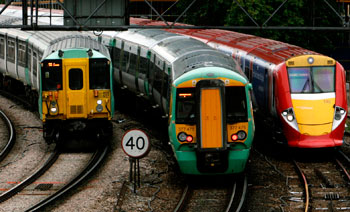Rail fares face 6.2 per cent increase
Train passengers face a rise in rail fares of an average of 6.2 per cent in January – an “outrageous” figure that masks the real rise from individual companies, campaigners tell Channel 4 News.
The Association of Train Operating Companies (Atoc) today announced the 6.2 per cent figure as an average rise of train fares – but some routes face much steeper rises.
The organisation gave no details of what the rise would be for each individual train company, nor did it break down the figures into regulated fares – which include season tickets and account for around 40 per cent of all fares – and unregulated fares.
Under the current annual price cap formula, fares can increase each January only by the previous July’s RPI inflation rate plus 1 per cent.
This means that in January 2011, regulated fares will rise by an average of 5.8 per cent – suggesting a higher rise in unregulated fares.
Passengers on services run by the Southeastern train company have their own personal price formula of RPI plus 3 per cent, due to the extra investment in services which include the 140mph Javelin trains.
This figure will mask rises on some routes of more than 10 per cent. Ashwin Kumar, Passenger Focus
The 5.8 per cent figure thus becomes 7.8 per cent for the Southeastern customers whether they use the new Javelin trains or not.
As the January rise is only an average figure, some regulated fares are likely to go up by 10 per cent or more.
Atoc’s Michael Roberts told Channel 4 News that currently half the cost of running the railways was met by the taxpayer and half from the passengers. “Government policy is to see taxpayers pay a smaller share in the future and that is why the fares policy is as it is,” he explained.

Rail fares: what are the costs?
Virgin Trains, which operates London to Scotland services on the West Coast Main Line, said its regulated fares were going up by an average of 5.8 per cent and its unregulated ones by an average of 5.4 per cent.
First Great Western (FGW) said its average fare rise was 6.0 per cent, with unregulated fares going up by an average of 6.15 per cent.
An FGW anytime return from Plymouth in Devon to Looe in Cornwall goes down 20 per cent, but a Cardiff-Bristol off-peak day return will be rising 8.08 per cent and an Oxford-London off-peak return goes up 7.5 per cent.
On Southeastern, where regulated fares are rising by an average of 7.8 per cent, a Margate to London annual season ticket will be going up 12.8 per cent.
The Southern train company said some of its regulated fares would be going up by 7.8 per cent.
A Brighton to London season ticket on Southern rises 7.76 per cent in January, going up from £3,556 to £3,832, while an Eastbourne to London season ticket increases 7.77 per cent to £3,940.
The East Coast rail company, which services destinations including Leeds, Newcastle and Edinburgh, said prices would increase by an average of 5.4 per cent.
Regulated and unregulated fares on First Capital Connect will rise by an average of 5.5 per cent.
Weekly from Hatfield in Hertfordshire to London (without travelcard) is £51.70 per week and will be £55 per week from January - or £2,200 per year, compared to £2,068 currently.
Including a London travelcard, the cost rises from £78.60 per week to £80 - or annually from £3,144 to £3,200.
‘Outrageous’
Gerry Doherty, leader of the TSSA rail union, said the rise was “simply outrageous”.
Ashwin Kumar, director of the rail watchdog Passenger Focus, said: “It is disappointing Atoc has still not told passengers what they will face in January.
“Yet again they have put out the average fare rise rather than details for individual train companies. This figure will also mask rises on some routes of more than 10 per cent. Passengers deserve to know how much of the burden they will have to bear in January.”
Atoc chief executive Michael Roberts said: “We know times are tough for many people but next year’s fare increases will ensure that Britain can continue investing in its railways.
“Even with these fare increases, the money passengers spend on fares covers only half the cost of running the railways – taxpayers make up the difference. The Government is sticking with the previous administration’s policy to cut the taxpayers’ contribution to the overall cost of running the railways.”
-
Latest news
-
Windrush scandal: returning to the UK after a forty year wait6m

-
Netanyahu ‘survival’ depends on ‘expanding war’ says head of Palestinian National Initiative5m

-
Proposed law change could strip parental rights from paedophiles5m

-
Hugh Grant settles privacy lawsuit against The Sun newspaper publisher2m

-
Post Office Scandal: what did top executive know?6m

-




